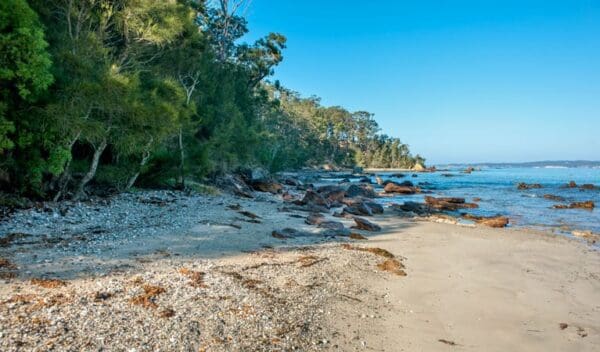Hike at a Glance
Max elevation: 38m
Min elevation: 19m
Total Ascent: 58m
Hike overview
The Honeysuckle Beach walking track offers a scenic 2.5-kilometer return journey through Murramarang National Park, just north of Batemans Bay. This moderate grade 3 hike is ideal for those seeking breathtaking south coast views without heavy crowds, and takes roughly 1.25 hours to complete.
The path winds through wind-sculpted spotted gums, culminating in a lookout point boasting picturesque island views. Birdwatchers will delight in spotting white-breasted sea eagles soaring overhead, while the black-pebbled shores of Honeysuckle Beach teem with marine life. Keep an eye out for gannets, shearwaters, petrels, and the threatened sooty oystercatcher foraging on the rocks.
The pristine beach beckons with opportunities for swimming in crystal-clear waters or picnicking on the soft sand. Anglers can cast a line for whiting, tailor, or snapper, but remember to check regulations as the area is part of a marine park. After soaking up the beauty, simply retrace your steps or extend your stay by camping at the nearby North Head campground.
Track grade
Grade 3 (Moderate) - Walks for Most Fitness Levels: Grade 3 on the AWTGS represents moderate walking tracks. These are ideal for walkers with some fitness who are comfortable with some hills and uneven terrain. While suitable for most ages, some bushwalking experience is recommended to ensure a safe and enjoyable experience. Tracks may have short, steep hill sections, a rough surface, and many steps. The total distance of a Grade 3 walk can be up to 20 kilometers.
Walk map and GPX file
Max elevation: 38 m
Min elevation: 19 m
Total climbing: 58 m
Total descent: -58 m
Content use
Please don’t copy GPX files or content from this site to AllTrails or other platforms. Each trail has been personally mapped, documented, and refined to support Australia’s bushwalking and hiking community. While some details come from land managers, every listing reflects significant personal effort. This is a free, community-driven initiative—your respect helps keep it that way.
Gallery
Got any photos from this hike? Your photos can help others plan. Share shots from along the trail so fellow hikers know what to expect.
Click to add your photos >>
Getting there
Getting to the trailhead: Murramarang National Park.
Accessible by car, the Honeysuckle Beach walking track resides within the southern precinct of Murramarang National Park. To reach the trailhead, take the turnoff from the Princes Highway into the park at Benandarah. Follow Durras Road for roughly 2 kilometers before veering right onto North Head Road. Continue along this road for approximately 10 kilometers until reaching North Head Campground. Look for signage directing you to the carpark, where you can conveniently park your vehicle before commencing your hike.
As the road conditions can deteriorate after rainfall, it’s advisable to check the weather forecast before setting out for Honeysuckle Beach walking track.
Need a rental car to get you to the hike? Find one here.
About the region
Murramarang National Park, a nature lover's paradise, stretches along 44 kilometers of dramatic coastline on the NSW south coast, near Batemans Bay. Here, visitors can camp under the shade of spotted gum trees that grow right down to the oceanfront, creating a stunning backdrop for a year-round escape. The park offers a variety of activities. Hike or bike along the trails, explore the cliffs and headlands, or relax on pristine beaches. Take a dip in the ocean, go surfing, or cast a fishing line for your dinner. Keep an eye out for eastern grey kangaroos and the abundant birdlife that call the park home.
The park is particularly famous for the multi-day Murramarang South Coast Walk, a spectacular 3-day adventure for experienced hikers. But there are options for all fitness levels. Explore the Durras Lake discovery trail, perfect for a family outing with children, or rent a canoe to paddle around the calm waters of Durras Lake. Whether you're looking for a day trip or a longer stay, Murramarang National Park has something for everyone. Choose from a variety of camping options, including caravan and motorhome sites with amenities, or book a cabin for a more comfortable stay.
Find a place to stay
Wondering where to stay near this hike? Find accommodation close to the trailhead — hotels, cabins and campgrounds nearby. Click the button to view the interactive map.
Closest towns to this walk: Batemans Bay, Bawley Point, Kioloa, Maloneys Beach, Malua Bay, Milton, Moruya, Narooma, Nelligen, North Durras, Tomakin, Ulladulla
Let someone know
Heading out? Fill in a trip intentions form so someone knows your plans. If things go wrong, they can raise the alarm fast, giving you peace of mind on the trail.
Similar walks nearby
Looking for more walks in or near Murramarang National Park? Try these trails with a similar difficulty grade.
Suggest an edit
Notice something different about this trail? Whether it’s a new feature, a route change, or a closure, share your update so we can keep our info accurate and helpful for fellow hikers.
Click to suggest edits >>
Explore safe
Plan ahead and hike safely! Carry enough water, pack layers for changing conditions, and bring safety gear like a torch, PLB, and reliable communication device. Check official sources for trail updates, closures, and access requirements, and review local weather and bushfire advice. Most importantly, share your plans with someone before you go. Being prepared makes for a safer and more enjoyable hike! Stay Safe, Explore More, and Always #ExploreSafe.
Packing checklists
What you carry in your pack depends on factors like weather, terrain, and your adventure type. Not sure what to bring? My free planning, food, and packing checklists are a great starting point, covering day hikes, overnight trips, and multi-day adventures. Use them to customise your kit and always prioritise safety.
Acknowledgement of Country
Trail Hiking Australia acknowledges the Traditional Owners of the lands on which we hike and pay respects to their Elders, past and present, and we acknowledge the First Nations people of other communities who may be here today.






